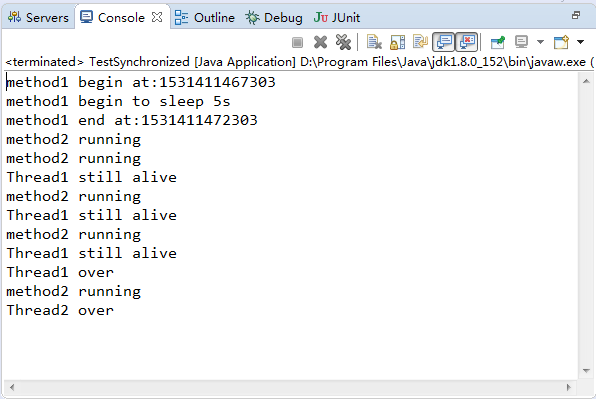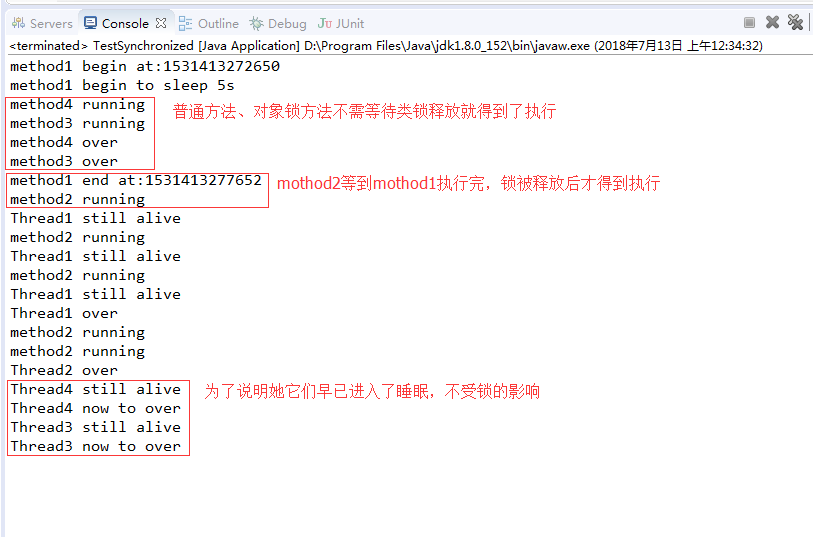编程开发之--java多线程学习总结(1)问题引入与概念叙述
1、经典问题,火车站售票,公共票源箱,多个窗口同时取箱中车票销售
package com.lfy.ThreadsSynchronize; /** * 解决办法分析:即我们不能同时让超过两个以上的线程进入到 if(num>0)的代码块中 * 1、使用 同步代码块 2、使用 同步方法 3、使用 锁机制 */ public class TicketSell1 extends Thread{ //定义一共有 50 张票,注意声明为 static,表示几个窗口共享 private static int num = 50; //调用父类构造方法,给线程命名 public TicketSell1(String string) { super(string); } @Override public void run() { //票分 50 次卖完 for(int i = 0 ; i < 50 ;i ++){ if(num > 0){ try { Thread.sleep(10);//模拟卖票需要一定的时间 } catch (InterruptedException e) { // 由于父类的 run()方法没有抛出任何异常,根据继承的原则,子类抛出的异常不能大于父类, 故我们这里也不能抛出异常 e.printStackTrace(); } System.out.println(Thread.currentThread().getName()+"卖出一张票,剩余"+(--num)+"张"); } } } }
2、对于解决办法,java中专门提供了synchronized关键字处理多线程同步问题,有了synchronized关键字,多线程程序的运行结果将变得可以控制。synchronized关键字用于保护共享数据。synchronized实现同步的机制:synchronized依靠"锁"机制进行多线程同步,"锁"有2种,一种是对象锁,一种是类锁。synchronized关键字修饰普通方法时,获得的锁是对象锁,也就是this。而修饰静态方法时,锁是类锁,也就是类名.class。
阻塞:A、B线程同时运行,由于锁的控制,某时刻A线程还能继续执行,B线程被挂起等待了,就说B线程被阻塞了。
(1)对象锁,使用synchronized修饰多个普通方法,当不同线程调用同一个对象的不同被synchronized修饰过的方法时,第一个调用被synchronized修饰过的方法的线程会得到对象锁,其他线程处于阻塞状态,直至第一个得到锁的线程退出被synchronized修饰过的方法。举个例子:
package lfy; public class TestSynchronized { public synchronized void method1() throws InterruptedException { System.out.println("method1 begin at:" + System.currentTimeMillis()); System.out.println("method1 begin to sleep 5s"); Thread.sleep(5000); System.out.println("method1 end at:" + System.currentTimeMillis()); } public synchronized void method2() throws InterruptedException { for(int i=0;i<5;i++) { System.out.println("method2 running"); Thread.sleep(200); } } static TestSynchronized instance = new TestSynchronized(); public static void main(String[] args) { Thread thread1 = new Thread(new Runnable() { @Override public void run() { try { instance.method1(); } catch (InterruptedException e) { e.printStackTrace(); } for(int i=1; i<4; i++) { try { Thread.sleep(200); } catch (InterruptedException e) { e.printStackTrace(); } System.out.println("Thread1 still alive"); } System.out.println("Thread1 over"); } }); Thread thread2 = new Thread(new Runnable() { @Override public void run() { try { instance.method2(); System.out.println("Thread2 over"); } catch (InterruptedException e) { e.printStackTrace(); } } }); thread1.start(); thread2.start(); } }
运行结果:

解释:创建了一个对象实例instance,创建两个线程Thread1、Thread2,它们分别调用instance的mothod1、mothod2方法,由于线程1先启动并先访问到被synchronized修饰的mothod1,此时instance对mothod2上锁,线程2此时只能等待mothod2的锁被释放,才能执行mothod2方法。这就是对象锁机制。
(2)类锁,对所有对象调用被synchronized修饰的static方法进行锁定,没有被synchronized修饰的static方法不会被上锁。
package lfy; public class TestSynchronized { public synchronized static void method1() throws InterruptedException { System.out.println("method1 begin at:" + System.currentTimeMillis()); System.out.println("method1 begin to sleep 5s"); Thread.sleep(5000); System.out.println("method1 end at:" + System.currentTimeMillis()); } public synchronized static void method2() throws InterruptedException { for(int i=0;i<5;i++) { System.out.println("method2 running"); Thread.sleep(200); } } /** * 没有static、synchronized修饰的普通方法 * @throws InterruptedException */ public void method3() throws InterruptedException { System.out.println("method3 running"); Thread.sleep(200); } /** * 只有synchronized修饰的普通方法 * @throws InterruptedException */ public synchronized void method4() throws InterruptedException { System.out.println("method4 running"); Thread.sleep(200); } static TestSynchronized instance1 = new TestSynchronized(); static TestSynchronized instance2 = new TestSynchronized(); static TestSynchronized instance3 = new TestSynchronized(); static TestSynchronized instance4 = new TestSynchronized(); public static void main(String[] args) { Thread thread1 = new Thread(new Runnable() { @Override public void run() { try { instance1.method1();
//TestSynchronized.mothod1(); } catch (InterruptedException e) { e.printStackTrace(); } for(int i=1; i<4; i++) { try { Thread.sleep(200); } catch (InterruptedException e) { e.printStackTrace(); } System.out.println("Thread1 still alive"); } System.out.println("Thread1 over"); } }); Thread thread2 = new Thread(new Runnable() { @Override public void run() { try { instance2.method2();
//TestSynchronized.mothod2(); System.out.println("Thread2 over"); } catch (InterruptedException e) { e.printStackTrace(); } } }); Thread thread3 = new Thread(new Runnable() { @Override public void run() { try { instance3.method3(); System.out.println("method3 over"); Thread.sleep(10000); System.out.println("Thread3 still alive"); System.out.println("Thread3 now to over"); } catch (InterruptedException e) { e.printStackTrace(); } } }); Thread thread4 = new Thread(new Runnable() { @Override public void run() { try { instance4.method4(); System.out.println("method4 over"); Thread.sleep(10000); System.out.println("Thread4 still alive"); System.out.println("Thread4 now to over"); } catch (InterruptedException e) { e.printStackTrace(); } } }); thread1.start(); thread2.start(); thread3.start(); thread4.start(); } }
运行结果:




